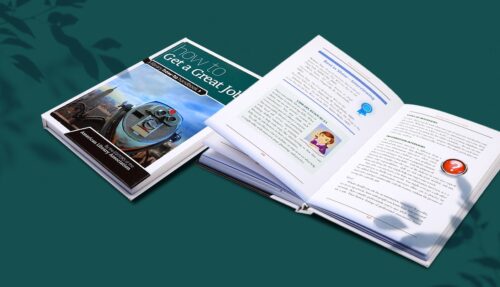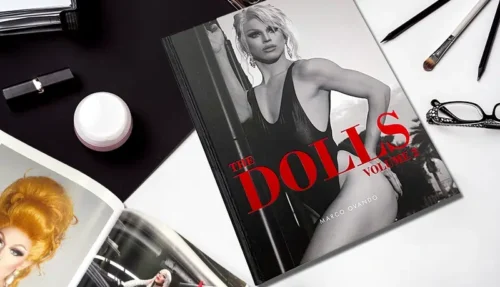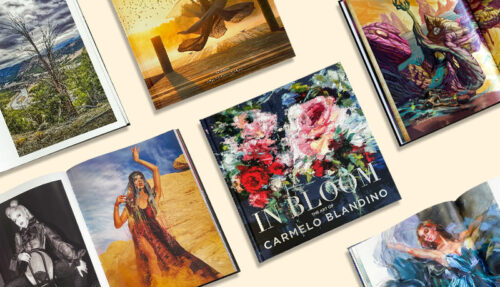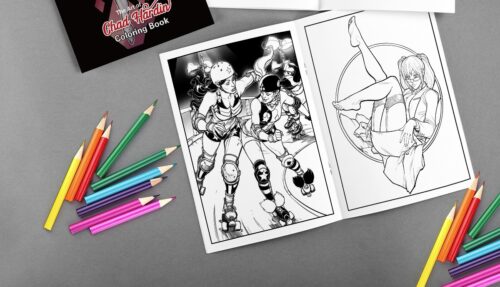Digitization is an essential stage in contemporary comic book layout, design, and printing. But most professional comic book artists we work with prefer to start with traditional materials or combine trad methods with digital processes. Drawing on their recommendations, these are our top picks of ten essential tools for creating comic book art today, including both analog and digital options.
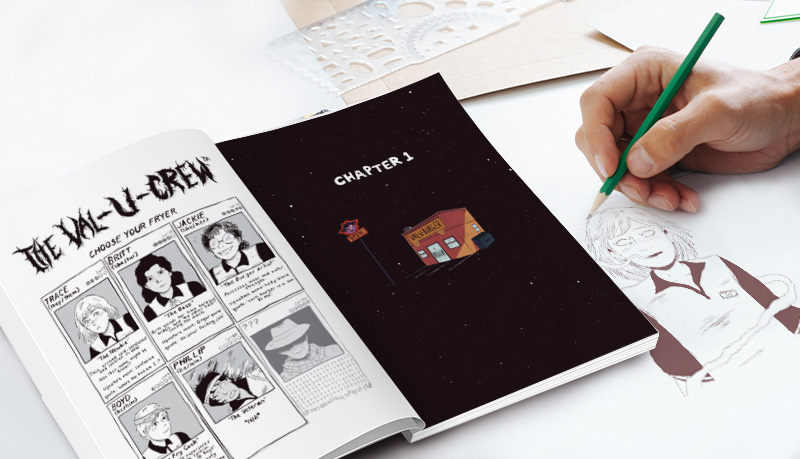
Comic book art is a unique and captivating medium that combines storytelling, illustration, and graphic design. Whether you’re an aspiring comic book artist just setting out or a seasoned professional with several successful publications already under your belt, having the right tools is essential to bring your ideas to the page and, not least, develop an easy and enjoyable workflow. As one of the world’s most reputable international offset printers, we’ve printed comics and graphic novels for famous comic artists like Juanjo Guarnido (Blacksad), Chad Townsend (Black Phantom / Batman / Iron Man), and indie enterprises like Wolven Press alongside a host of talented comic book artists and writers who may not be globally famous but you’d recognize from the bookstores and conventions.
We’ve been in the business for almost 30 years now and we’ve worked with more comic book artists than you could shake a fine marker at! Based on that experience, and conversations we’ve had with our clients about how they work and what they prefer, we’d like to share what we consider the 10 essential tools for comic book artists that will help you create interesting, dynamic, beautiful comic book pages. So, without further ado, let’s hit the list!
1. Pencils — for comic art storyboarding
Pencils are the foundation of any comic book artwork. They allow artists to sketch out their ideas, create rough layouts, and add details to their drawings. When choosing pencils for comic book art, it’s important to consider the lead graphite hardness and quality. Some artists prefer traditional wooden pencils with a softer lead for quick sketching, while others opt for mechanical pencils for more control.
Pencil grades explained:
You may already have seen that pencils come in different grades. The grade is usually printed or embossed on the top end of the pencil shaft furthest away from the writing point. These grades indicate how light/hard or dark/soft a pencil is. The grades are composed of a letter and a number. The letters are as follows.
H (Hardness): Lighter lines due to more filler material and less graphite in the make up of the pencil core.
B (Blackness): Darker lines because they’re softer with more graphite and less filler.
The numbers after the letters refer to the relative lightness or darkness of the marks the pencil can make within each category. These grades range from 9H, which is both the hardest and makes the lightest marks, to 9xxB which is very soft and makes the darkest marks.
If you’re just starting out, any of the popular sets made by a reputable brand should do well. These sets typically include pencils from 2H to 6B allowing for a variety of techniques.
There are also special pencil grades for specific uses.
EE pencils: Made from a mix of graphite and charcoal, giving a dark, matte finish.
F Pencil Grade: F stands for “Fine”, making it hard and good for extremely delicate, fine details.
Here’s an easy-to-understand table that shows you how to use the different grades of pencils to their best advantage when selecting them for use in your comic book art and design.
How to Use Different Pencils:
| Pencil Grade | Best Use |
|---|---|
| 9H – 5H | Best for light sketches, like for watercolor paintings. |
| 4H – 2H | Good for technical drawings and light outlines. |
| H, F, HB, B | Great for everyday sketches and writing. HB is the most versatile. |
| B Grades | Ideal for shading, blending, and creating dark tones. |
| EE Pencils | Perfect for very dark shading with a matte finish. |
Choosing Your Pencils
There’s no need to buy every grade. Most good sets cover all the basics. We don’t know any artists who have and use all the grades! Start with a basic set and add just what you need as you discover your style and the range that best suits your work. That said, having a variety helps you experiment and find what suits your style, which is why we recommend that you invest in a set to get started. Or if you buy them individually, then choose a very hard/light pencil and a very soft/dark one and then pick a few in between those extremes to make up your own set.
Non-photo blue pencils are popular among comic book artists as they create marks that are not detected by scanners or cameras. The advantages of that are you can put down your sketch lines without worrying about needing to erase them once you finish inking as they won’t show on the digitally photographed version you’ll prepare for print.
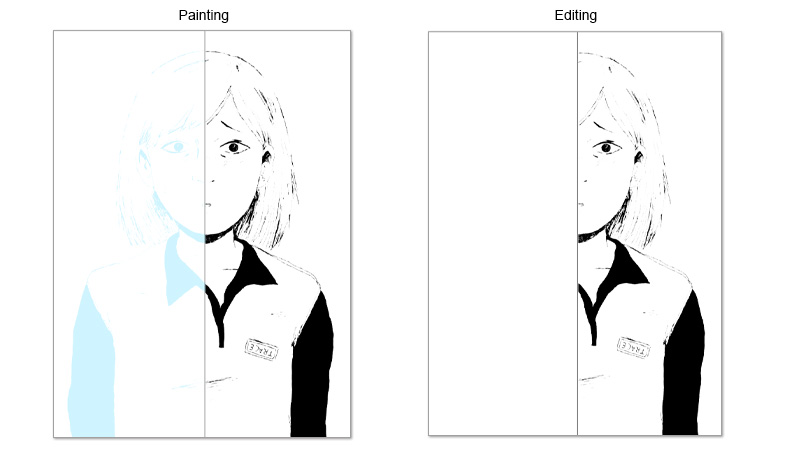
2. Paper — for drawing comics
Choosing the right paper is vitally important for creating comic book art that looks professional, takes pencil marks, inks, and other media well, and stands the test of time. Bristol paper is the most popular choice among comic book artists because of its smooth surface quality and ability to handle various inking techniques. Smooth Bristol paper is ideal for fine grade pen and ink work, while vellum Bristol paper offers more grip for softer pencil or pen drawings. It’s worth experimenting with the size and weight of the paper based on your preferred comic book format.
Types of Bristol Paper:
| Smooth (Plate) Finish | Vellum Finish | |
|---|---|---|
| Surface | Ultra-smooth, almost glossy. | Slightly textured, with a bit of tooth. |
| Best for | Pen and ink work, markers, and fine detail drawing. | Pencils, charcoal, and ink, as well as mixed media. |
| Why comic artists love it | The smooth surface allows for crisp, clean lines and is perfect for the precise, controlled inking that comic book art often requires. It also works well with technical pens and markers, as the ink doesn't bleed or feather. | The texture of vellum Bristol provides better grip for dry media like graphite or charcoal, making it great for rough sketches and shading. It's also versatile enough for ink work, though it can give a different, more textured effect than the smooth finish. |
In summary, then, Bristol paper is popular among the comic book artists we asked because of its durability, versatility, and professional finish. Its heavier weight, typically ranging from 250 to 400 gsm, allows it to withstand multiple layers of ink and paint without warping or bleeding. This makes it ideal for the mixed techniques often used in comic art, as it performs well with various media like pencil, ink, markers, and light watercolor washes. The clean, smooth surface of Bristol paper ensures a polished, professional look that reproduces well when scanned or photographed, which is important for printing. Ink sits neatly on Bristol paper without smudging, providing the sharp, precise lines essential for comic panels. Bristol paper is widely available in various sizes and formats, making it convenient for artists to work at any scale.
3. Drawing boards, rulers, and compasses — for designing comics
Having an angled, flat surface on which to work is essential. Drawing boards can be simple tray-type designs or full, free standing professional drafting tables. A drawing board provides a stable and smooth surface that supports your hand and helps you produce clean, consistent lines. The firm base also prevents paper from warping or bending while you’re drawing or inking.
Rulers are invaluable for maintaining straight lines and accurate proportions, essential for the clean, geometric elements of comic book panels. They help you align the panels, borders, and text boxes with precision, so that each page follows your layout plan. With a quality ruler, you can create consistent and professional-looking grids and frames, which contribute to a polished final product. They’re also great for drawing dynamic explosion blast lines!
Compasses are used to draw perfect circles and curves, which are often required for elements like speech bubbles, round symbols, and other design details.
Precise measurements and straight lines with careful geometry and perspectives are super-important in comic book art, especially in the superhero and graphic novel verticals. So, these tools are a must. A wide range of other geometric tools are out there, but these are the two – a ruler and compasses – that our artists consider essential.
4. Pen and inks -- for outlining and coloring comic layouts
As you will almost certainly know, inking is a fundamental step in comic book art that adds depth, definition, and polish to your drawings while also allowing you to define the sketched elements you want to keep in the final print. There are various tools and techniques for inking, and it’s important to find what works best for your style and preferences.
Dip Pens: Dip pens are a traditional tool for comic book inking, favored for their flexibility and control. They consist of a nib, which is dipped in ink and then used to draw on paper. Dip pens are excellent for creating fine lines and intricate details, making them ideal for detailed illustrations and nuanced inking. Their flexibility allows you to vary line thickness and texture, providing a range of effects from delicate cross-hatching to bold, expressive strokes. However, they require regular dipping and careful maintenance to prevent ink clogging, and it can take a while to learn how to use them effectively. So, make time to practice plenty on something unimportant before you start work on your masterpiece!
Technical Pens: Technical pens are designed for precision and consistency, making them a popular choice for comic book artists who need uniform lines. These pens use a refillable ink reservoir and have a fixed nib size, which makes sure that every line is of the same width and quality. They are particularly useful for drawing fine lines and intricate details with consistent results, ideal for creating clean, professional-looking artwork. Technical pens are also convenient for artists who prefer not to manage ink dipping and nib replacement.
Brushes: Brushes offer versatility and a wide range of line qualities, making them a favorite for dynamic and expressive inking. They can produce varying line widths and textures, from fine, delicate lines to broad, sweeping strokes. Brushes are excellent for adding fluidity and depth to comic book art, particularly for creating dramatic effects and shading. They require skill to control and maintain, as well as regular cleaning to keep the bristles in good condition.
Markers: Markers are known for their convenience and ease of use, providing a range of colors and line qualities. They come in various nib sizes and types, such as fine tips for detailed work and broad tips for filling in large areas. Markers are particularly useful for adding vibrant colors and solid black areas quickly, making them ideal for both inking and coloring. They are a good choice if you’re looking for efficiency and bold, striking contrasts in your comic book pages.
Fountain Pens: Fountain pens are prized for their smooth ink flow and the ability to create both fine and expressive lines. They use a refillable ink reservoir and come in various nib sizes, allowing for versatility in line thickness and texture. Fountain pens are well-suited for artists who prefer a more refined and elegant line quality, often used in detailed illustrations where control and subtlety are important. They require regular cleaning, drying, and maintenance to prevent clogging and guarantee consistent performance.
Digital Pens: Digital pens used with tablets and graphic software offer the advantage of immediate adjustments and infinite undo options. They simulate traditional inking tools with a digital stylus, allowing for precise control over line quality and shading. Digital pens are obviously a necessity if you work in a digital medium, providing flexibility to experiment with various effects and easily correct mistakes. They also facilitate the integration of color and texture directly within the digital workspace.
We recommend exploring a range of options to find the best fit for your style and working methods. Several of the artists we’ve worked with prefer to include the latest manga pens in their toolkit, so that’s probably an avenue worth exploring.
5. Light table or light box – for transfer and development of comic images
As with any creative process, comic book art generation is an iterative process and you’ll need to do a lot of copying from earlier drafts. A light table or light box—which may sometimes be integrated into your drawing surface—is an invaluable tool for comic book artists, especially during the penciling and inking stages of iterative drafting. It provides a back light that allows you to trace or transfer your sketches or isolated elements onto the final drawing surface. This is useful when working with reference images or when creating consistent character profiles, silhouettes, proportions, and perspectives.
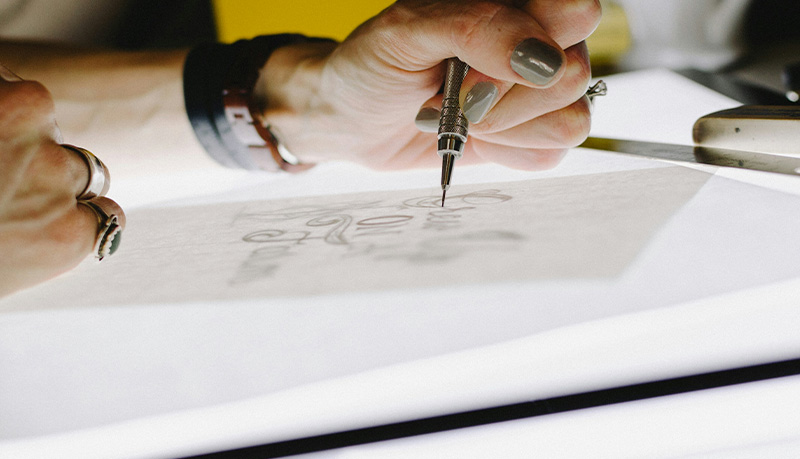
6. Erasers – for correcting comic art errors
Erasers are essential for correcting mistakes and refining your artwork. With comic book art, precision and clean lines are super-important, so having a variety of erasers can be really beneficial. Kneaded erasers are versatile and can be shaped to erase unimportant details, while vinyl erasers are excellent for removing larger areas of graphite or ink.
Kneaded Erasers:
- Application: Excellent for lightening pencil marks and creating subtle shading effects. You can use them to lift graphite gently without damaging the paper or removing too much of the underlying lines.
- Benefits: Ideal for erasing detailed areas and creating texture or highlights. The ability to mold the eraser into different shapes allows for precise control in fine detail work.
Vinyl Erasers:
- Application: Effective for removing pencil lines and graphite quickly and cleanly. They are useful for erasing larger areas or making significant corrections.
- Benefits: Provide a clean, sharp erasure without smudging or tearing the paper. Their firmness makes them suitable for erasing solid lines and detailed work, but they can sometimes leave small bits of eraser residue.
It’s a good idea to keep both to hand. We also spoke to several comic book artists who use erasers to smudge and blur both graphite and ink in order to create specific visual effects.
7. Brushes – for texturing and adding depth to comics
Brushes are essential tools for adding texture, shading, and depth to your comic book art. They allow you to achieve a wide range of effects, from delicate lines to bold strokes, fills and washes. Different brushes offer unique characteristics, such as bristle type, shape, and size.
Round brushes: made from synthetic or natural hairs such as sable. These are versatile tools essential for detailed line work and expressive strokes. Their pointed tips allow for precise control and variation in line width, making them indispensable for intricate comic art.
Liner brushes: designed for fine details and delicate work. Often constructed from synthetic fibers or high-quality natural hairs, these brushes come in fine to extra-fine grades. Their long, thin shape guarantees consistent, controlled application of ink, which is important for detailing in comic panels.
Flat brushes: which can be made from synthetic or natural hairs like hog bristle, have a rectangular shape that is perfect for bold lines and large areas. They are available in various grades, with higher-quality versions offering better control and durability. Their flat shape allows you to achieve clean edges and even coverage, making them ideal for background elements and panel borders.
Filbert brushes: combine the qualities of round and flat brushes with their rounded, flat shape. Made from synthetic or natural hairs, they are versatile tools that excel at blending, creating soft edges, and detailing. Their rounded tips offer versatility in brush strokes, making them useful for both detailed and broader applications.
Mop brushes: typically made from soft natural hairs like squirrel or goat hair. These are particularly good for applying washes and covering large areas. They hold a significant amount of liquid, making them excellent for creating gradients and filling in backgrounds. While less common for fine detail work, mop brushes are valuable for comprehensive page layouts and background applications.
Experimenting with various brushes will help you find the ones that best suit your artistic style. Start with a basic sable brush set and expand and refine your choices based on your experience and practical needs.
8. Markers – for versatility and invention
Markers are all too often overlooked by beginner comic book artists. But they are dynamic, easy, versatile tools that can add vibrant colors and impressive effects to your comic book art panels. They are useful for coloring, shading, and creating gradients.
Alcohol-based markers are favored for their smooth blending, quick drying, and vibrant colors, ideal for rich, saturated gradients and detailed work.
Water-based markers are less toxic and produce translucent effects, making them suitable for light washes and subtle layering.
Brush markers offer flexible nibs that mimic paintbrushes, allowing for varied line thicknesses and dynamic strokes.
Fineliner markers are known for their fine, precise tips, perfect for detailed line work and clean outlines.
Gel markers provide opaque, vibrant colors with a smooth application, useful for vivid highlights and special effects.
Metallic and glitter markers add shiny or reflective finishes, making them ideal for accents and decorative elements.
But you can experiment with all kinds from kids’ felt tips to professional architect models. One joy of comic book art is the freedom it allows you to try out new ideas and mix and match media to achieve the desired effects. Make markers part of the mix.
9. Digital drawing tablets
Okay, so we started out emphasizing the continued importance of traditional materials in comic book art but all professional design and printing these days has to involve digitization and many comic book artists we work with have either transitioned to creating their artwork digitally or combine traditional and digital methods in their working practice. Digital drawing tablets offer a range of features and benefits, including pressure sensitivity, customizable brushes, and the ability to make corrections and edits with ease. They also provide a potentially more efficient workflow, allowing you to work seamlessly from sketching, to inking, to coloring.
But they also have limitations, especially in terms of size and tactility. For that reason, we—and most of the comic book artists we asked—still think that some combination of traditional and digital tools usually produces the most beautiful and satisfying results. But no modern comic book designer should be without a digital drawing tablet, even if it’s only used for sketching our concept layouts on the move. And whichever tablet you choose, you’ll need software to go with it. These are the top recommendations from our artists:
Certainly! Here’s the revised list:
Adobe Photoshop is a versatile and widely used digital art software known for its powerful tools for drawing, coloring, and texturing. It offers extensive brush customization, layer management, and blending modes, making it a favorite among professional comic artists for its advanced color correction and text tools.
Manga Studio 5 / Clip Studio Paint is designed specifically for comic and manga creation, providing a range of tools tailored for this art form, including panel layouts, speech bubbles, and screen tones. Its customizable brushes, vector layers, and 3D models make it ideal for detailed comic art.
Procreate is a popular digital drawing app for iPad, appreciated for its intuitive interface and robust drawing tools. It features a wide range of brushes, layering options, and is suitable for both sketching and detailed work.
Corel Painter mimics traditional media with realistic brush textures and effects, making it ideal for artists who prefer a painterly feel. Its extensive brush library and customizable brushes allow for a traditional look in digital painting.
Adobe Illustrator is known for its vector-based drawing capabilities, offering precision for clean, scalable line art and graphic elements. Its vector graphics support and integration with Adobe Creative Cloud apps make it a valuable tool for detailed comic art.
Sketchbook Pro is a user-friendly digital drawing application that provides a natural drawing experience with various brushes and tools. Its clean interface and support for multiple layers and blending modes make it a solid choice for digital artists.
ArtRage simulates traditional art techniques with a focus on realistic textures and brush strokes. Its realistic paint textures and blending tools offer a traditional painting experience in a digital format.
Affinity Designer is a vector graphic design tool known for its precision and performance, suitable for creating detailed comic art and illustrations. It supports both vector and raster graphics and offers comprehensive design tools.
Krita is an open-source digital painting application with a range of tools for comic and digital art. Its advanced brush engines, layer management, and support for comic templates and frame layouts make it a popular choice for comic artists.
In our design department here at QinPrinting, we favor the Adobe Creative Suite—so, Illustrator, InDesign, Photoshop—but we can and often do work with a range of other software options depending on our artist’s preferences. In the end, which you choose comes down to personal preferences, budget, and compatibility with your hardware.
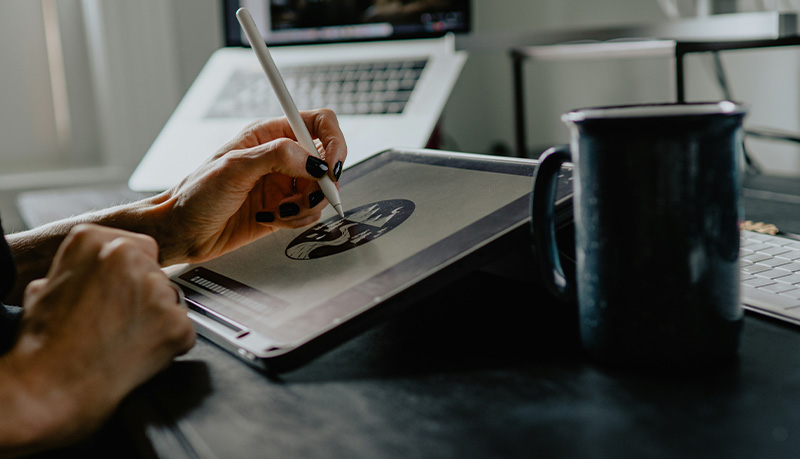
10. Reference materials and resources
Art does not spring from nothing. Having access to reference materials and resources is invaluable for comic book artists. Whether it’s books on anatomy, perspective guides, or online tutorials, these resources can provide inspiration, guidance, and technical knowledge to enhance your artwork. Building a library of reference materials and following other comic book artists’ work can help you develop your own unique style.
To sum up, then, the right tools are essential for you, as a comic book artist, to bring your creative visions to the page with professionalism, technical accuracy, and aesthetic flair. From pencils and paper to inking tools and digital drawing tablets, each tool plays a critical role in the artistic process. Experiment with different tools and techniques to find what works best for your style and storytelling. If you have a favorite tool that we’ve not mentioned here, don’t let us get away with it – let us know in the comments!
Ready to print? Talk to us!
If you’re a self-publisher, an independent creative, or a publishing house wanting to print a comic book — and only the finest product and unbeatable customer service will do — we should talk. When it comes to printing your comics, we have the expertise, the technical know-how, and the commitment to every customer that has led to and sustained our unrivaled global reputation as one of the finest independent offset printers anywhere in the world. Just shoot us an email to [email protected] or just call us on +1 951 866 3971 and one of our expert team members will be delighted to help and answer all your questions.We can’t wait to help you make your next comic the best!






